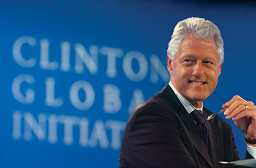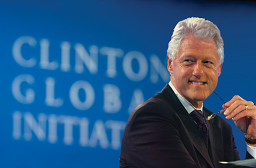 Cross-posted from the Wonk Room.
Cross-posted from the Wonk Room.
President Bill Clinton believes the “number one thing” to restore the American economy is clean, efficient energy. In a blogger roundtable at the beginning of his Clinton Global Initiative in New York City, Clinton told us his “favorite ideas” for making the green economy a political and economic reality:
One: Federal loan guarantees for building energy efficiency retrofits
Two: Renewable energy initiatives in economically depressed cities
Three: Green jobs programs for poor Americans
Clinton, relaxed and slim, held court with a dazzling mastery of policy details, wit, and storytelling. Citing a Center for American Progress report on the promise of energy efficiency, Clinton described his desire for the federal government to kickstart private financing of energy retrofits, much as the Clinton Foundation had done for the Empire State Building:
The Center for American Progress says we can get half the way home to an 80 percent reduction in greenhouse gases by 2010 by efficiency alone. Unemployment in construction is 25 percent. We can’t go out and build new houses. And there are very few office buildings that need to be built. So what I think we should do is to have a lot more Empire State Buildings. We should retrofit every public school, every college and university building every hospital, every auditorium in this country, and every office building unencumbered by debt.
Clinton believes the reason that this investment hasn’t already happened is that “spooked” banks don’t want to make loans that could collapse. His solution is to establish a federal loan guarantee program, which he believes could create one million jobs with only $15 billion in federal investment:
Give them a federal guarantee like the SBA guarantee, and you only have to set aside $1 for every $10 you loan. Still very conservative, because we know the historic failure rate is one percent, not ten percent. It might not cost the taxpayers anything.
Here’s the multiple: every billion-dollar investment in retrofits gives you 7000 jobs. Homes 8000. Wind energy 3300 if you build and assemble the windmills where you put them up. Solar 1900, coal 870, nuclear a little over 900. This is not close. If you want to put America back to work, give a loan guarantee, get banks to start making loans.
Set aside $15 billion for guarantees, you get $150 billion in bank lending, you get a million jobs.
His other policy ideas are about making the clean energy economy real for the American people, rich and poor:
My second candidate: pick places that are both distressed and full of potential for energy independence. My number one candidate is Nevada, where the sun shine and the wind blows. And you’ve got all those real expensive hotels there with roofs that could be filled with solar panels. And you have all the hills around that could be filled with windmills.
I would say take a few places like that and go straight out and make them energy independent and document how many jobs have been created, and then everybody will want to do that.
My third candidate is prove it works for poor people. One of our best commitments is designed to provide after-school jobs and summer jobs for poor kids in Harlem, upper Manhattan Washington heights by paying them to go in and retrofit a lot of these old buildings, whitewashing the black roofs.
If you did those three things so that every day you were proving over and over again to all the naysayers that it was good economics to build a clean energy future, you can build a consensus necessary to do what has to be done. You could beat the special interest groups.
He admitted that the key problem with this vision is that it requires a change from how the energy sector traditionally makes money:
If you make a deal for a nuclear power plant or a coal-fired power plant and you knowingly deprive all these jobs increase greenhouse gas emissions or you increase other risk or you increase huge costs — with nuclear, it’s always more expensive — the only real reason they do it is because they’ve always done it that way, and it is so much simpler. If you’re running the utility, there’s one contractor that’s going to build that plant, there’s one supplier of the fuel, and then you go to one PUC and they give you permission to make the ratepayers pay for it at a profit. It’s simple because it’s centralized.
The new energy economy is more decentralized, but it’s less expensive, more job intensive, and parenthetically will save the planet.
“That’s what I think we have to do,” Clinton concluded. “You’ve got to prove this is good economics. And it is! The number one thing we could do for America is change the way we produce and consume energy.”



